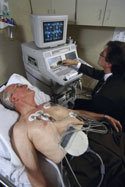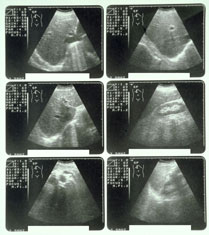After the physical exam, blood and heart tests have been completed and a diagnosis of HF is confirmed, the physician usually will classify, or "rank," the patient's heart failure. The ranking is based on how severe the symptoms are.
The most commonly used system to classify heart failure is called the New York Heart Association (NYHA) Functional Classification. Heart failure patients are placed in one of four categories, depending on how their condition affects the performance of normal physical activities. The four categories are:
 Class I:
Class I: People in this category feel no symptoms and can perform ordinary physical activity without any limitations. Approximately 35 percent of people with heart failure are in Class I.
Class II: Another 35 percent of people with heart failure are in Class II. They have mild symptoms, such as occasional swelling (edema), and may be somewhat limited in their ability to exercise or do other strenuous activities. They do not feel any symptoms when they are at rest.
Class III: These individuals are noticeably limited in their ability to exercise or participate in mildly strenuous activities. They are comfortable only when they are at rest. About 25 percent of people with heart failure are in this class.
Class IV: The most severe form of heart failure occurs in about 5 percent of patients. These individuals are severely limited in their ability to perform any activity, and they have symptoms even when they are resting.
 Class I: People in this category feel no symptoms and can perform ordinary physical activity without any limitations. Approximately 35 percent of people with heart failure are in Class I.
Class II: Another 35 percent of people with heart failure are in Class II. They have mild symptoms, such as occasional swelling (edema), and may be somewhat limited in their ability to exercise or do other strenuous activities. They do not feel any symptoms when they are at rest.
Class III: These individuals are noticeably limited in their ability to exercise or participate in mildly strenuous activities. They are comfortable only when they are at rest. About 25 percent of people with heart failure are in this class.
Class IV: The most severe form of heart failure occurs in about 5 percent of patients. These individuals are severely limited in their ability to perform any activity, and they have symptoms even when they are resting.
Class I: People in this category feel no symptoms and can perform ordinary physical activity without any limitations. Approximately 35 percent of people with heart failure are in Class I.
Class II: Another 35 percent of people with heart failure are in Class II. They have mild symptoms, such as occasional swelling (edema), and may be somewhat limited in their ability to exercise or do other strenuous activities. They do not feel any symptoms when they are at rest.
Class III: These individuals are noticeably limited in their ability to exercise or participate in mildly strenuous activities. They are comfortable only when they are at rest. About 25 percent of people with heart failure are in this class.
Class IV: The most severe form of heart failure occurs in about 5 percent of patients. These individuals are severely limited in their ability to perform any activity, and they have symptoms even when they are resting.






